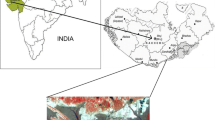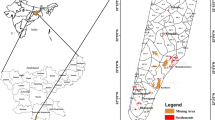Abstract
Conservation and management of Sundarban mangrove forest is difficult chiefly due to inaccessibility and hostile condition. Remote sensing serves as an important tool to provide up-to date baseline information which is the primary requirement for the conservation planning of mangroves. In this study, supervised classification by maximum likelihood classifier (MLC) has been used to classify LANDSAT TM and LANDSAT ETM satellite data. This algorithm is used for computing likelihood of unknown measurement vector belonging to unknown classes based on Bayesian equation. Image spectra for various mangrove species were also generated from hyperspectral image. During field visits, GPS locations of five dominant mangrove species with appreciable distribution were taken and image spectra were generated for the same points from hyperion image. The result of this classification shows that, in 1999 total mangrove forest accounted for 55.01 % of the study area which has been reduced to 50.63 % in the year 2010. Avicennia sp. is found as most dominating species followed by Excoecaria sp. and Phoenix sp. but the aerial distribution of Avicennia sp., Bruguiera sp. and Ceriops sp. has reduced. In this classification technique the overall accuracy and Kappa value for 1999 and 2010 are 80 % and 0.77, 85.71 % and 0.81 respectively.






Similar content being viewed by others
References
Aschbacher J, Ofren RS, Delsol JP, Suselo TB, Vibulsresth S, Charrupat T (1995) An integrated comparative approach to mangrove vegetation mapping using remote sensing and GIS technologies: preliminary results. Hydrobiologia 295:285–294
Banerjee AK (1964) Forests of Sundarban. Forest Department, Calcutta, Centenary Volume
Banerjee LK (2002) In: Shing NP, Shing KP (eds) Floristic diversity and conservation strategies in India, vol. V, botanical survey of India. Ministry of Environment and Forests, pp. 2801–2829
Blasco F, Aizpuru M (1997) Classification and evolution of the mangroves of India. Trop Ecol 38:357–374
Blasco F, Saenger P, Janodet E (1996) Mangroves as indicators of coastal change. Caten 7:167–178
Blasco F, Aizpuru M, Gers C (2001) Depletion of the mangroves of Continental Asia. Wetl Ecol Manag 9:245–256
Chander G, Markham BL, Barsi JA (2007) Revised Landsat- 5 thematic mapper radiometric calibration. IEEE Geosci Remote Sens Lett 4:490–494
Chavez PS Jr (1996) Image-based atmospheric corrections – revisited and improved. Photogramm Eng Remote Sens 62(9):1025–1036
Choudhury AB, Choudhury A (1994a) Mangrove of the Sundarbans. The IUCN Wetland Program, India, vol. 1
Choudhury AB, Choudhury A (1994b) Mangroves of the Sundarbans. Vol. 1. World Conservation Union, India, p 247, Gland
Congalton RG, Green K (2009) Assessing the accuracy of remotely sensed data: principles and particles, 2nd edn. CRC Press, Boca Raton
Duggin MJ, Robinove CJ (1990) Assumptions implicit in remote sensing data acquistion and analysis. Int J Remote Sens 11(1):1669–1694
Dwivedi RS, Rao BRM, Bhattacharya S (1999) Mapping wetlands of the Sundarban delta and its environs using ERS-1 SAR data. Int J Remote Sens 20:2235–2247
Farooq S, Govil H (2014) Mapping regolith and gossan for mineral exploration in the Eastern Kumaon Himalaya, India using hyperion data and object oriented image classification. doi:10.1016/j.asr.2013.04.002
Gopal B, Chauhan M (2006) Biodiversity and it’s consevation in the Sundarban Mangrove Ecosystem. Aquat Sci 68:338–354
Green EP, Clark CD, Mumby PJ, Edwards AJ, Ellis AC (1998a) Remote sensing techniques for mangrove mapping. Int J Remote Sens 19:935–956
Green EP, Mumby PJ, Ellis AC, Edwards AJ, Clark CD (1998b) The assessment of mangrove areas using high resolution multispectral air borne imagery. J Coast Res 14:433–443, http://www.portal.gsi.gov.in. Accessed 9 Sept 2013
Hazra S, Ghosh T, Dasggupta R, Sen G (2002) Sea level and associated changes in sundarban. Sci Cult 68:309–321
Islam MJ, Alam MS, Elahi KM (1997) Remote sensing for change detection in the Sundarbans, Bangladesh. Geocarto Int 12:91–100
Khan MAR (1986) Wildlife of Bangladesh mangrove ecosystem. J Bombay Nat Hist Soc 83:32–48
Kuenzer C, Bluemel A, Gebhardt S, Quoc TV, Dech S (2011) Remote sensing of mangrove ecosystems: a review. Remote Sens 3:878–928
Kushwaha SPS, Dwivedi RS, RAO BRM (2000) Evaluation of various digital image processing techniques for detection of coastal wetlands using ERS-1 SAR data. Int J Remote Sens 21:565–579
Lillesand TM, Kiefer RW, Chipman JW (2004) Remote sensing and image interpretation, 5th edn. Wiley, Singapore
Mandal RN, Das CS, Naskar KR (2010) Dwindling Indian Sundarban mangrove. Sci Cult 76(7–8):275–282
Nandy S, Kushwaha SPS (2011) Study on the utility of IRS 1D LISS-III data and the classification techniques for mapping of Sundarban mangroves. J Coast Conserv 15:123–137
Naskar KR (2004) Manual of Indian mangroves. Daya Publishing House, New Delhi
Naskar KR, Chakraborty NM (1984) Studies on the economic fauna from the Sundarbans delta in West Bengal. J Indian Soc Coast Agric Res 2:56–62
Naskar KR, Mandal RN (1999) Ecology and biodiversity of Indian mangrove. Vol. 1 & 2. Daya Publishing House, New Delhi
Nayak S, Sarangi RK, Rajawat AS (2001) Application of IRS P4 OCM data to study the impact of cyclone on coastal environment of Orissa. Curr Sci 80:1208–1213
Ramsey EJ, Jensen RJ (1996) Remote sensing of mangrove wetlands: relating canopy spectra to site-specific data. Photogramm Eng Remote Sens 62:939–948
Reddy CS, Pattanaik C, Murthy MSR (2007) Assessment and monitoring of mangroves of Bhitarkanika Wildlife Sanctuary Orissa, India using remote sensing and GIS. Curr Sci 92:1409–1415
Roy PS (1989) Mangrove vegetation stratification using Salyut 7 photographs. Geocarto Int 3:31–47
Scott A, Symons M (1971) Clustering method based on likelihood ratio criteria. Biometrics 27:387–397
Singh IJ, Singh SK, Kushwaha SPS, Ashutosh S, Singh RK (2004) Assessment and monitoring of estuarine mangrove forests of Goa using satellite remote sensing. J Indian Soc Remote Sens 32:167–174
Snedaker SC (1982) Mangrove species zonation: why? Tasks Veg Sci 2:111–125
Sobrino JA, Jimenez-Munoz JC, Paolini L (2004) Land surface temperature retrieval from LANDSAT TM 5. Remote Sens Environ 90:434–440
Song C, Woodcock CE, Seto KC, Lenney MP, Macombe SA (2001) Classification and change detection using Landsat TM data: when and how to correct atmospheric effects? Remote Sens Environ 5:230–244
Sulong I, Lokman MH, Tarmizi K, Ismail A (2002) Mangrove mapping using LANDSAT imagery and aerial photographs: Kemamam district, Terengganu, Malaysia. In: Dahdouh-Guebas (ed) Remote sensing and GIS in the sustainable management of tropical coastal ecosystems, environment, development and sustainability. 4(2), pp. 93–112
Tomlinson PB (1986) The Botany of Mangroves; Cambridge University Press: Melbourne, VIC, Australia
Upadhyay VP, Ranjan R, Shing JS (2002) Human mangrove conflicts: the way out. Curr Sci 83:1328–1336
Verhayden A, Dahdouh-Guebas F, Thomaes K, De Genst W, Hettiarachchi S, Koedam N (2002) High-resolution vegetation data for mangrove research as obtained from aerial photography. Environ Dev Sustain 4:113–133
Author information
Authors and Affiliations
Corresponding author
Rights and permissions
About this article
Cite this article
Giri, S., Mukhopadhyay, A., Hazra, S. et al. A study on abundance and distribution of mangrove species in Indian Sundarban using remote sensing technique. J Coast Conserv 18, 359–367 (2014). https://doi.org/10.1007/s11852-014-0322-3
Received:
Accepted:
Published:
Issue Date:
DOI: https://doi.org/10.1007/s11852-014-0322-3




